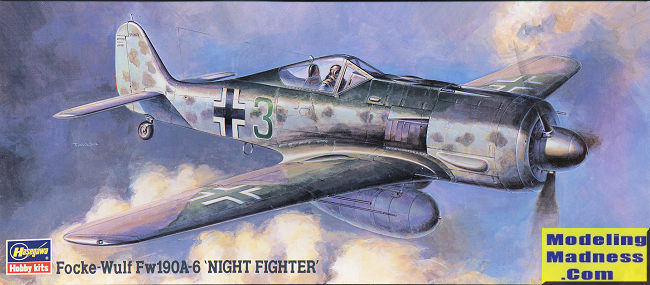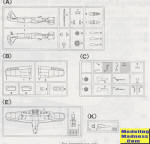
Hasegawa 1/72 FW-190A-6 'Night Fighter'
| KIT #: | 52044 (AP144) |
| PRICE: | 1200 yen when new |
| DECALS: | One option |
| REVIEWER: | Scott Van Aken |
| NOTES: | 1997 release |

| HISTORY |
The Fw 190 A-6 was developed to address shortcomings found in previous "A" models when attacking U.S. heavy bombers. Modifications of the type to date had caused the weight of the aircraft to creep up. To combat this and to allow better weapons to be installed in the wings, a structurally redesigned lighter, stronger wing was introduced. The normal wing armament was increased to four 20 mm MG 151/20E wing root and outer wing cannon with larger ammunition boxes while retaining the two MG 17 fuselage machine guns. New electrical sockets and reinforced weapon mounts were fitted internally in the wings to allow the installation of either 20 mm or 30 mm (1.18 in) ammunition boxes as well as for underwing armament. Because the outer wing MG 151s were mounted lower than the MG/FFs, new, larger hatches incorporating bulges and cartridge discharge chutes, were incorporated into the wing lower surfaces. It is believed the fuselage MG 17s were kept because their tracer rounds served as a targeting aid for the pilots. A new FuG 16 ZE radio navigation system was fitted in conjunction with a FuG 10 ZY. A loop aerial for radio navigation, mounted on a small "teardrop" base was fitted under the rear fuselage, offset slightly to port, with an additional short "whip" aerial aft of this. These aerials were fitted on all later Fw 190 variants.
The A-6 was outfitted in numerous ways with various sets, Rüstsätze (field modification kits); more flexible than the factory upgrade kits for previous versions, these field upgrade kits allowed the A-6 to be refitted in the field as missions demanded. At least 963 A-6s were built from July 1943 ending in April 1944, according to Ministry of Aviation acceptance reports and Focke-Wulf production books. In late 1943, the Erla Maschinenwerke's Antwerp factory designed a simpler rack/drop-tank fitting, which was more streamlined than the bulky ETC 501 and could be quickly fitted or removed.
| THE KIT |
 For
many years, the Hasegawa 1/72 FW-190 series was the best there was. Earlier
offerings from a variety of manufacturers, including an earlier Hasegawa kit,
were all lacking, with shape errors that were difficult to correct. This one was
first tooled in 1992, followed by literally dozens of boxings, several of them
being combo kits. The last ones were released in 2014/2015, probably due to the
more detailed Academy, Revell, Zvezda, Airfix, and later Eduard kits. All of
Hasegawa's 1/72 190s were A-5 and later variants. They also did the 190D-9.
For
many years, the Hasegawa 1/72 FW-190 series was the best there was. Earlier
offerings from a variety of manufacturers, including an earlier Hasegawa kit,
were all lacking, with shape errors that were difficult to correct. This one was
first tooled in 1992, followed by literally dozens of boxings, several of them
being combo kits. The last ones were released in 2014/2015, probably due to the
more detailed Academy, Revell, Zvezda, Airfix, and later Eduard kits. All of
Hasegawa's 1/72 190s were A-5 and later variants. They also did the 190D-9.
These kits are not complex and don't suffer from a plethora of small parts that one often deals with when it comes to newer kits. The cockpit is a simple tub with a seat, stick and instrument panel. Decals for the instrument faces. This is trapped in the fuselage halves and the upper cowling, tailplanes and prop assembly are then attached. The prop comes with separate, keyed, blades. Then one assembles the wing, opening any holes that are required and for the A-6, the variant of this kit, you will need to open some holes for the upper cannon fairings and the pitot. You also need to trim away the outboard pitot tube as that is for the later versions. .
 Landing gear
is simple and sturdy. A centerline rack is provided for a drop tank. These kits have the tail gear molded in place so care does need to be taken when
building. The canopy and windscreen are separate with this kit only offering the
early version.
Landing gear
is simple and sturdy. A centerline rack is provided for a drop tank. These kits have the tail gear molded in place so care does need to be taken when
building. The canopy and windscreen are separate with this kit only offering the
early version.
Instructions have Gunze paint references and the markings option is RLM 74/75/76 in the standard pattern. In addition to the box art plane from Stab./JG 300, you are provided additional numbers to do other planes from this unit. These are 'old school' Hasegawa decals where the white is off-white, but still appear to be quite usable.
| CONCLUSIONS |
I've built most of the earlier and some of the later 190s in this scale, and find the Hasegawa version to be one that I like the best. This is mostly due to the ease of construction and the fact that the finished product looks nice. If you find these at a reasonable price on the 'used' kit market, pick it up. I'm sure you will be pleased.
| REFERENCES |
https://en.wikipedia.org/wiki/List_of_Focke-Wulf_Fw_190_variants#A-6
January 2022 Copyright ModelingMadness.com. All rights reserved. No
reproduction in part or in whole without express permission. If you would like your product reviewed fairly and fairly quickly, please contact the editor or see other details in the
Note to
Contributors. Back to the Main Page
Back to the Review
Index Page
Back to the Previews Index Page